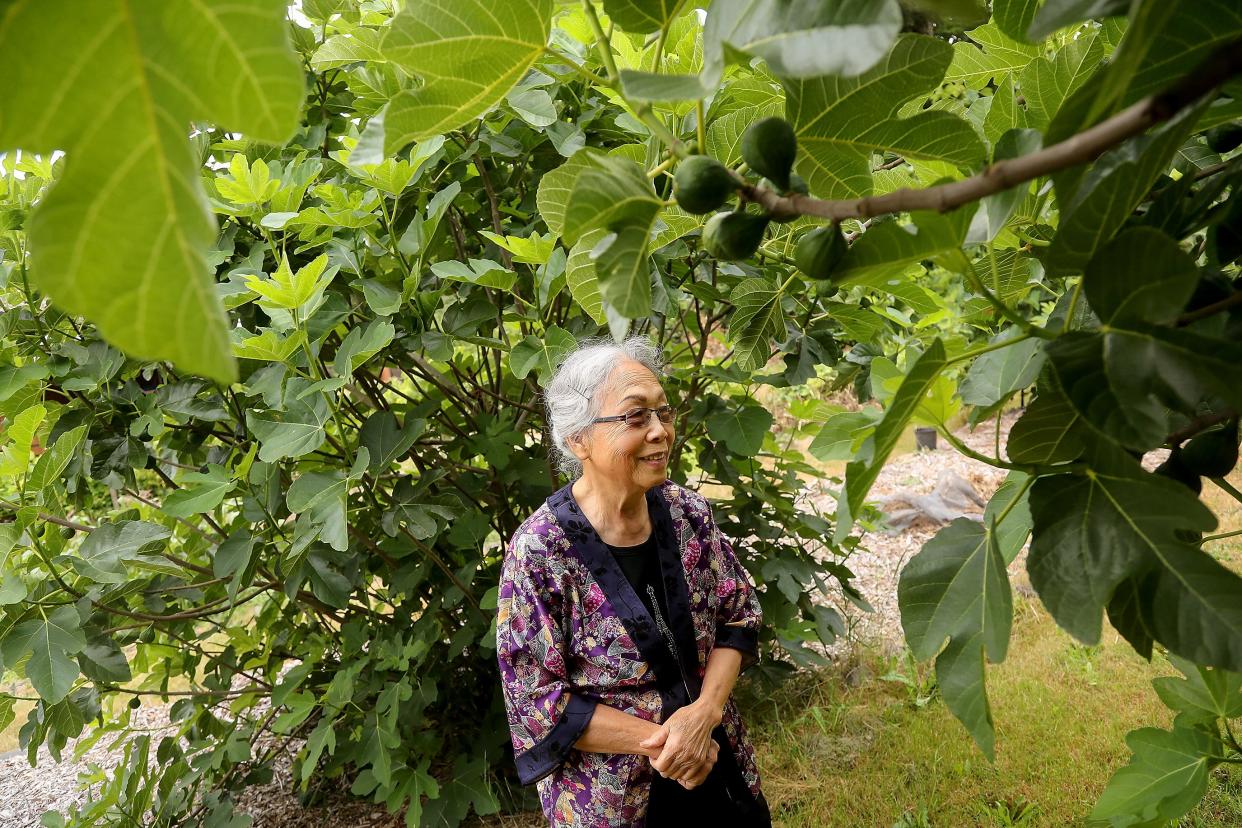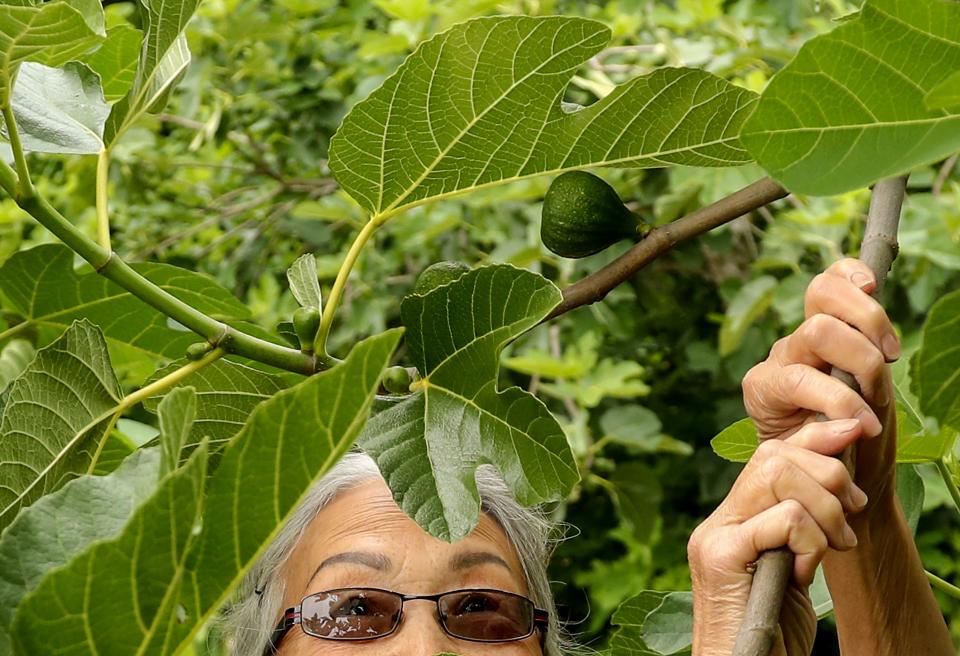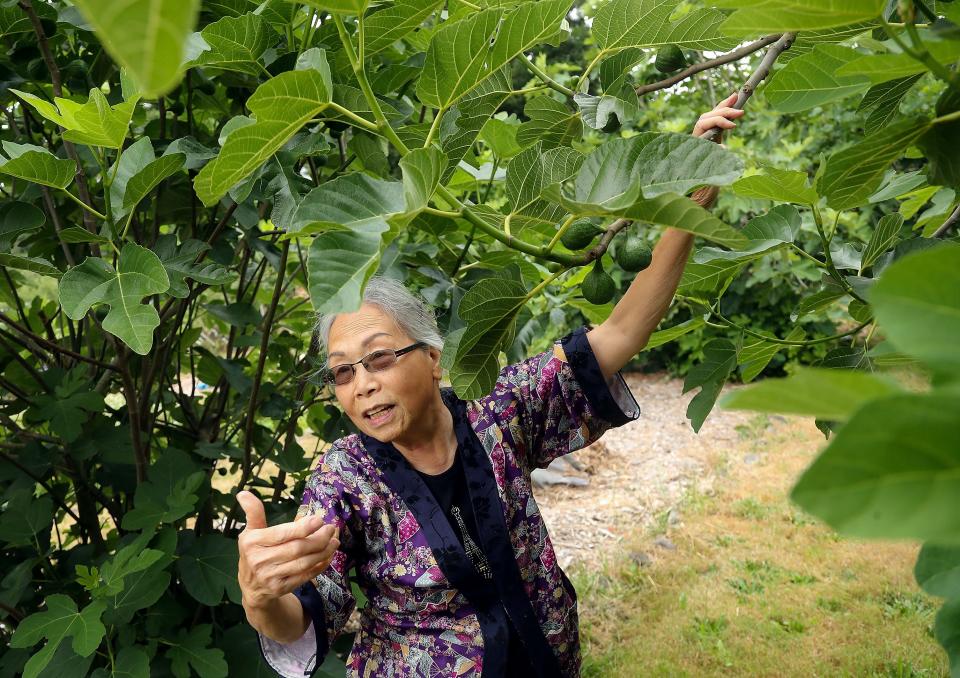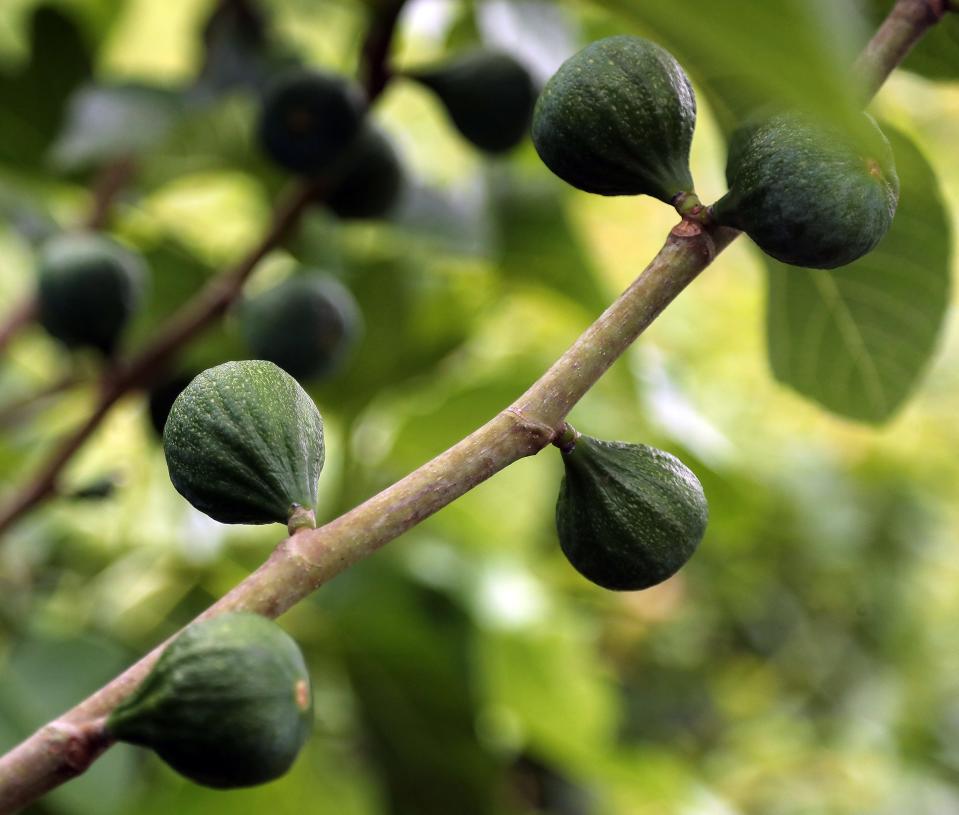Love at first fig bite 25 years ago launched thriving Silverdale orchard

The sensual experience of biting through the skin of a fresh fig, savoring its nuanced sweetness and crunching on its tiny seeds, is among summer’s great pleasures. It’s all the sweeter if the fig is grown in Puget Sound country and just plucked from a tree.
I experienced a personal fig epiphany while traipsing through Kim Hedahl’s hillside fig orchard near Silverdale. The sun beat down on us that August day, but Kim’s mature fig trees offered shade as we sampled one delicious variety after another: Desert King, roundish and green with a pink interior; Brown Turkey, teardrop shaped, with gold to maroon skin and deep pink flesh; Vern’s Brown Turkey, Lattarulla, and Giant California — all delectable.
It was love at first bite when a friend offered Kim, a native of Vietnam, a freshly plucked, sun-warmed fig from her Desert King tree. Kim was inspired to grow her own. The friend obliged with rooted cuttings from her tree, and Kim’s life changed course. In the 1990s, she and her husband, Loren, ran a thriving business out of their Silverdale farm, growing culinary herbs and wholesaling them to area supermarkets. They reached a turning point when a major grocery chain offered them the use of a warehouse and a contract to supply nearly 200 stores. Accepting the offer would mean relocating, starting a field growing operation from scratch, and scaling up.
Instead, they pulled out the herbs and turned the business over to a partner. The Desert King cuttings had grown into large trees by then, and after Loren pruned one severely it put out a mass of suckers. Thrifty Kim stuck them into an unused corner of the garden, covered them with a clear plastic umbrella and kept them watered with a soaker hose. She tried other varieties, and eventually, a new venture took root.
Twenty-five years later, Kim has narrowed her varieties from 10 to five and sells 1,000-2,000 pounds of fresh figs from her orchard every summer, mostly Desert King. She also produces dried figs in her state-of-the-art food dehydrator.

Many people associate figs with the Garden of Eden, desert climates or Greek statues. Figs are native to the Mediterranean region and may be the earliest crop cultivated by humans. Fossilized figs dating from 9400 to 9200 B.C. were found in the Neolithic village of Gilgal, near Jericho, the world's oldest continually-inhabited city.
Kim Hedahl may have planted the first fig orchard in Kitsap County, but she’s not the first to embark on a quest to find varieties that reliably ripen fruit in the Puget Sound region’s heat-challenged climate. The grail of fresh, tree-ripened figs has tantalized Northwesterners for over a century.
In the early 1900s, B.R. Amand of Portland discovered a tree with ripe figs in a vacant lot and dug up rooted suckers near its base. The five resulting trees eventually became the basis of “Mother’s Garden,” a popular tourist attraction and mail order business. Local fig fanciers talk of a commercial fig-growing venture on Vashon Island during the same era. More recently, a retired biologist living in Elma tracked down fig trees between Surrey, B.C., and Eugene, Oregon, that ripen fruit, then worked with a geneticist at UC Davis to compare their DNA with the USDA collection of over 200 genetically distinct varieties.
A false fruit
Botanically speaking, a fig is not a fruit. It’s a hollow, fleshy stem (synconium), that en-closes a soft white lining and a jelly-like mass of flowers with multiple tiny seeds. Equally unusual, the hidden inner flowers are pollinated by a specific species of wasp, which enters the fig through a tiny hole (ostiole) in the rounded end. The wasps can’t survive in the Northwest, but fortunately, there are also “persistent” or “common” figs that don’t need pollination.
Many of these self-fertile varieties ripen in Puget Sound country. In late fall, tiny embryonic fruits form in the leaf axils (where leaves meet stems) on new growth from that summer. These buds develop the following spring and, provided with enough heat, ripen an early, or breba, crop.
A few varieties — including Lattarulla, Dan’s Favorite, and Violetta — may ripen a second crop in autumn. Ripe figs may be green, bronze or mahogany-colored, with creamy to amber to pink flesh. Some varieties have three or four different shaped leaves on the same tree.
Harvesting and enjoying figs
Kim’s fig orchard is on a west-facing slope with fertile soil and full sun. Her heaviest bearing trees, which produce 50 or more pounds of figs a year, are spaced at least 25 feet apart. To minimize losses to birds, she harvests figs daily and hangs light-reflecting tape and old CDs from the trees’ upper branches. Figs can also be grown successfully in pots large enough to hold at least 25 gallons.

On our heavenly ramble through her orchard, Kim showed me how to tell if a fig is ripe — soft and drooping straight down from the branch — and made sure I picked them carefully to avoid bruising or ripping the stem end. The fruits are delicate and keep only a few days. They don’t continue to ripen after picking. She warned me to watch for wasps, too — some of the ripe fruits had split and exuded a little syrup that attracts them. Lucky Kim can eat a dozen a day in the height of the season, but not all digestive systems can handle that many.
Figs are among the most fiber-rich fruits, along with apples, pears, prunes and dates. They contain pectin, a soluble fiber that is digested in the large intestine and acts as a prebiotic, promoting the growth of beneficial gut bacteria. They’re high in minerals and rank with foods like red wine and green tea in antioxidant content. Their glycemic value is a moderate 61.
Enjoying figs
A simple presentation can highlight the unique flavor and texture of fresh figs, and they can transform an ordinary dish into something spectacular.
Try them au naturel, grilled or baked and paired with cheeses such as feta, mascarpone, gorgonzola, chevre or brie.
They’re superb atop a cheesecake or baked in tarts, and sumptuous dipped in melted chocolate, then chopped walnuts, hazelnuts or almonds.

Dried figs can also spark an epiphany. My memory of picking them sun-dried and concentrated from a wild tree in Morocco remains vivid after decades. Each one hung down like a purplish raindrop and filled my mouth with the flavor of ambrosial perfection.
Dried figs star in fruitcakes and English-style steamed puddings; they’re also delicious in Moroccan-inspired tagines, poached in fruit juice or port and served over ice cream, or combined with other dried fruits and nuts into healthy confections.
Still, for utter deliciousness and simplicity, it’s hard to beat a freshly harvested, locally grown fig. With summers getting warmer, expect to find more of these delectable fruits in markets and backyards throughout Puget Sound country.
Mary Preus earned an English Literature degree from the University of Washington and traveled the world for three years before starting an herb farm on the shores of Puget Sound. Her previous books include “The Northwest Herb Lover’s Garden,” “Growing Herbs,” “The Leek Cookbook,” and “A Little Book of Herbs for Cooking."
This article originally appeared on Kitsap Sun: Looking for figs in Puget Sound? Silverdale orchard offers bounty

